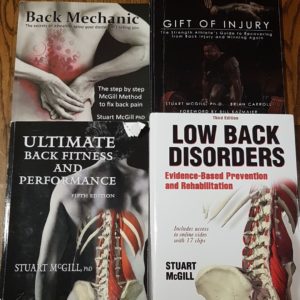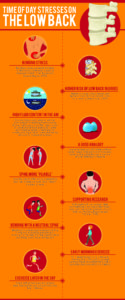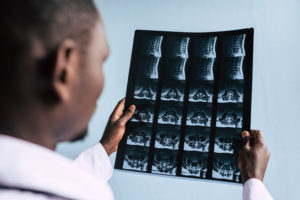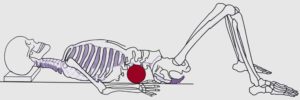
7 Recommendations for Returning to Weight Training After a Low Back Injury
Returning to weight training after sustaining a low back injury can be a difficult task.
You may be unsure about what exercises to do without making your back worse. Or perhaps you’re performing the right exercises, but you’re unsure about your technique and the frequency that you should be performing these exercises.
Lots of questions to ask. And for someone that is a novice to an intermediate gym-goer – this can be very confusing.
Going back 5 years ago, I can tell you, I didn’t know what the fuck I was doing.
I didn’t know how to squat or deadlift properly.
I didn’t know that sit-ups could create a disc herniation.
And I can tell you that I didn’t know a basic hamstring stretch could irritate a nerve root.
It wasn’t until I began studying the field of strength and conditioning and Dr. Stuart McGill’s work did I truly have an understanding of how to train without irritating symptoms or creating a back injury.
And that process started 6-7 months after injuring my low back.
About a year later I was pain-free through doing self-rehab.
And now fast forward to today – I’m helping people with back issues weight train without making themselves worse.
It’s a bit of an unexpected journey – since I expected to be working with hockey or basketball athletes. But the more time I spend in the low back pain community – I’m in shock at how many people don’t know how to weight train properly or are afraid to even touch a weight because of their low back!
Here is a recent example from a youtube subscriber seeking guidance on weight training with a back injury:
“Awesome video bro…. this has been my journey. Though I have not done weight training. I injured my back by overdoing ab exercises. Ever since then I have not been to the gym. I walk and swim to maintain weight. What do you suggest for me if I want to start weight training? A normal gym coach or a PT? What do you recommend for learning weight training?”
And here is my response:
“Thanks, buddy! I would first recommend getting a proper diagnosis from a skilled clinician if you don’t already have one. There are many causes of low back pain, and finding the root cause will give you and the trainer/coach a better understanding of how to work around your injury.
As for starting weight training in the gym – I’d suggest hiring a trainer/coach who is competent in the spine and can educate you about your back issues.
Low back pain can trigger by different movements, postures, and loads. And if you can find a good coach/trainer, they can perhaps identify and teach you what movements, postures, and loads trigger your back pain.
Often cleaning up people’s technique during various movement patterns and postures will allow people to train pain-free, and promote healing of damaged tissues. But this is something you’ll only find with a “quality” trainer, which can be hard to come by if you don’t know how to look for one.
If you need help finding a quality trainer/coach, feel free to message me, and I can perhaps send some recommendations your way.
Cheers,
Remi”
From my experience, I can relate to this subscriber since they’re in the process of trying to weight train, but don’t know how to go about it.
It’s not fun trying to work around a back injury. And when it comes to the gym, it can be a scary place if you don’t know what you’re doing.
Simply performing the wrong exercise can put you right back to were you started. Or perhaps even worse!
That’s why with today’s post, I would like to share with you 7 recommendations to help you return to weight training after sustaining a low back injury.
1. Hire a Quality Strength Coach or Personal Trainer
A major reason why people end up with back injuries is that they’re performing the wrong exercises in the gym, the technique is poor, and the load is too heavy.
Hiring a Strength Coach or Personal Trainer with knowledge in the low back can be one of the best investments you can make. If you find the right Strength Coach or Personal Trainer – they can perhaps help you with the following:
– identify pain-triggers, weakness and imbalance.
– understand how movements, posture and loads affect back pain.
– train you to adopt pain-free movement patterns that may help with recovery.
– build a resilient back through core endurance and spine stabilization exercises.
– correct mobility limitations
– coach you on how to deadlift and squat with proper technique
– work on specific athletic or exercises goals and focus on enjoying a pain-free life.
– accountability with your workout program
Trust me. If you can find a coach that can help you with the above, they’re a keeper!
And worth the $$$.
2. Study Dr. McGill’s Work
If you want to learn the in’s and out’s of low back injuries and exercise – Dr. McGill’s research is non-negotiable. I’d suggest reading the books Back Mechanic and Ultimate Back Fitness and Performance to get your knowledge up to date on low back pain. Also, if you’re a strength athlete, I’d recommend Gift of Injury. Low Back Disorders (McGill’s other book) is very clinical based, and I would only recommend to the person looking to advance their education in the low back.
3. Avoid Early Morning Exercise
From Adams, Dolan & Hutton’s (1987) research, we know that the ligaments and spinal discs of the lumbar spine are more prone to stress during bending activities in the early morning compared to later in the day.
People with back pain that is worse in the morning may only aggravate symptoms or cause more problems by performing spine bending exercises in the early morning. One may be wise to schedule workout sessions later in the day to spare the spine and minimize the chance of a low back injury.
4. Avoid Repeated Cycles of Flexion and Extension with a Compressive Force
Repeated spine bending (flexion/extension) with a moderate to high compression force is the mechanism for creating a disc herniation (Callaghan & McGill, 2001). And for this reason, exercises such as sit-ups (repeating cycles of flexion/extension with a high compression force) and supermans (repeating cycles of extension with a high compression force) are a poor exercise choice for a high majority of the population.
The spine is not meant to bend with a moderate to high compression force over and over again. That’s how the spine buckles and breaks. When it comes to exercise, better options exist than sit-ups and supermans, and that involves exercises that keep the spine neutral and spine compression forces to an acceptable level (e.g., birddog, planks).

DID YOU KNOW that ONE sit-up places 3,300 Newtons of compression force on the lumbar spine (McGill, 1995; Axler & McGill, 1997)? That’s equivalent to the safety limit of low back compression set by some government institutions (McGill, 2017). Image licensed from ‘AllaSerebrina/depositphotos.com”.
5. Identify You’re Pain Triggers and Avoid Them
If performing a hip-hinge causes pain – you perhaps should avoid this movement. Or if loading your spine with weight (135lbs back squat) causes pain – you perhaps should avoid this type of loading position. Regardless of the pain-trigger, it doesn’t make sense to move into pain-provoking positions.
Moving into pain provoking positions only irritates the damaged tissue and puts you into a worse condition to overcome your back pain. It’s best to wait until the pain winds down and the tissues heal before progressing in a weight training program.
6. Listen to Your Body!
Don’t push it in the gym when you’re dealing with back issues. Do what you can tolerate and be very careful with fatigue. I’d suggest taking frequent, and longer rest breaks in between sets and exercises. Also, if there is a day where you didn’t’ sleep well, found yourself sitting too long (e.g., travelling), or feeling sick – take a break from the gym. It’s better to wait until your feeling good or close to 100% before lifting weights.
7. Make Sure You Get a Proper Diagnosis
If you’re unsure about what is causing your back pain or haven’t had a proper diagnosis, find a qualified clinician. Backfitpro.com has a list of McGill Method Clinician’s that can perhaps provide you with the assessment you need!
In summary, returning to weight training after a back injury can be a scary task. But it doesn’t have to be if you follow the guidelines above. Hiring the right coach/trainer can make a night and day difference in your ability to exercise without making your symptoms worse and perhaps improve your existing back issues. Just be sure to not overdo your training, avoid your pain-triggers and be certain you have the correct diagnosis.
Salute,
Remi
References
1. Adams, M. A., Dolan, P., & Hutton, W. C. (1987). Diurnal variations in the stresses on the lumbar spine. Spine, 12(2), 130-137.
2. McGill, S.M. (1995). The mechanics of torso flexion: situps and standing dynamic flexion manoeuvres. Clinical Biomechanics (Bristol, Avon), 10(4), 184-192.
3. Axler, C. T., & McGill, S. M. (1997). Low back loads over a variety of abdominal exercises: Searching for the safest abdominal challenge. Medicine and Science in Sports and Exercise, 29(6), 804-811.
4. Callaghan, J.P., Gunning, J.L., McGill, S.M. (1998). Relationship between lumbar spine load and muscle activity during extensor exercises. Physical Therapy 78(1): 8-18.
5. Callaghan, J. P., & McGill, S. M. (2001). Intervertebral disc herniation: Studies on a porcine model exposed to highly repetitive flexion/extension motion with compressive force. Clinical Biomechanics (Bristol, Avon), 16(1), 28-37.
6. McGill, S. M. (2017). Ultimate Back Fitness & Performance (6th ed). Waterloo, ON: Backfitpro Incorporated.
Thumbnail Image Licensed from “Kobzev3179/depositphotos.com”
















